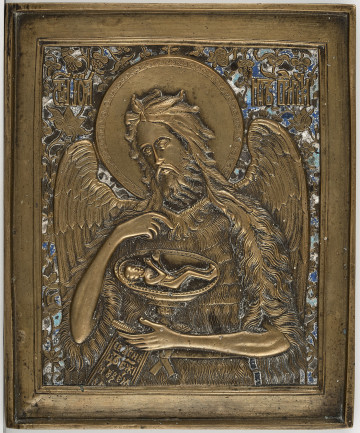
St. John the Baptist
20th century
Castle Museum in Łańcut
Part of the collection: Icons
The Old Testament proscription against creating depictions of the god Yahweh lost some of its importance with the coming of the Son of God. The New Testament, where Christ is called the Word Incarnate equivalent to the Father, the image of the Invisible God (John 14:9-10; Colossians 1:15), justifies creating depictions of him. This is why, according to the canons of the art of the Eastern Church, God was to be represented exclusively as Christ. Among the oldest images of the Saviour are depictions of the Omnipotence and the Divine Nature of Christ, called the Almightly, in Greek - Pantocrator. In the 4th-6th c., the Saviour as the Ruler of All began to be portrayed like an earthly ruler, with all the insignia of imperial dignity. The always front-facing figure of the Saviour was placed on the dome of the temple which symbolises the heavens. Over time, the portrayal of the Pantocrator took the central place in the depictions of Deesis, with the figures of the Mother of God and John the Baptist revering the enthroned Saviour and interceding on behalf of the human race. The image of Christ also appears in the Sovereign tier of an iconostasis. There are three variants of the Pantocrator image. His full figure can be depicted standing, he can be shown sitting on a throne, and, in later iconography, he is more often shown as a half-figure. The fingers of the right hand, raised to the level of the chest, are usually arranged in the form of the monogram IC XC, signifying the name of Christ. The placement of the fingers can, at the same time, be read as a symbol of the dual divine-human nature of the Saviour and the Holy Trinity. In later depictions, known in Western Christianity as Salvator Mudi or Ruler of the World, Christ holds a globe topped with a cross as a sign of his reign over the world, as shown on the displayed domestic use icon. The icon is decorated with a metal riza which repeats the outline of the painted figure. Teresa Bagińska-Żurawska https://orcid.org/0000-0002-9243-3967
Other names
Salvator Mundi
Dimensions
height: 13.5 cm, width: 11 cm
Object type
Icons
Technique
gilding, tempera, metalloplastics
Material
silver, brass, tempera, wood
Origin / acquisition method
decyzja administracyjna
Creation time / dating
Creation / finding place
Owner
Castle Museum in Łańcut
Identification number
Location / status

20th century
Castle Museum in Łańcut

19th (?) century
Castle Museum in Łańcut

1800 — 1850
Castle Museum in Łańcut
DISCOVER this TOPIC
National Museum in Szczecin
DISCOVER this PATH
Educational path